Spatial Variability of Soil Erodibility at the Rhirane Catchment Using Geostatistical Analysis
Abstract
1. Introduction
2. Materials and Methods
2.1. Study Area
2.2. Soil Sampling and Soil Erodibility Estimation
2.3. Statistical and Spatial Analysis
2.3.1. Analysis of Variance
2.3.2. Spatial Analysis and Statistics
3. Results and Discussion
3.1. Statistical Analysis of Soil Properties and Soil Erodibility
3.2. Variability of Physical Soil Properties with Soil Types
3.3. Association of Soil Aggregate Stability with Soil and Land Use
3.4. Relationship between K-Factor and Soil Properties
3.5. Geostatistical Analysis
4. Conclusions
Author Contributions
Funding
Institutional Review Board Statement
Informed Consent Statement
Data Availability Statement
Acknowledgments
Conflicts of Interest
References
- Cassol, E.A.; Silva, T.S.; Eltz, F.L.F.; Levien, R. Soil erodibility under natural rainfall conditions as the K factor of the universal soil loss equation and application of the nomograph fora subtropical Ultisol. Rev. Bras. Cienc. Solo 2018, 42, e0170262. [Google Scholar] [CrossRef]
- Veazy, A.R.; Bahrami, H.A.; Sadeghi, S.H.R.; Mahdian, M.H. Developing a nomograph for estimating erodibility factor of calcareous soils in North West of Iran. Int. J. Geol. 2011, 5, 93–100. [Google Scholar]
- Auerswald, K.; Fiener, P.; Martin, W.; Elhaus, D. Use and Misuse of the K factor equation in soil erosion modeling: An alternative equation for determining USLE nomograph soil erodibility values. Catena 2014, 118, 220–225. [Google Scholar] [CrossRef]
- Tilligkeit, J.K. The Spatial Distribution of K-Factor Values Across a Topo Sequence and a Soil Survey Map Unit. Unpublished. Master’s Thesis, The Faculty of California Polytechnic State University, San Luis Obispo, CA, USA, 2012; p. 43. [Google Scholar]
- Al Rammahi, A.H.J. Estimation of Soil Erodibility Factor in Rusle Equation for Euphrates River Watershed Using Gis. Int. J. Geomate 2018, 14, 164–169. [Google Scholar] [CrossRef]
- Liu, M.; Han, G.; Li, X.; Zhang, S.; Zhou, W.; Zhang, Q. Effects of soil properties on K factor in the granite and limestone regions of China. Int. J. Environ. Res. Public Health 2020, 17, 801. [Google Scholar] [CrossRef]
- Wang, B.; Zheng, F.; Guan, Y. Improved USLE-K factor prediction: A case study on water erosion areas in China. Int. Soil Water Conserv. Res. 2016, 4, 168–176. [Google Scholar] [CrossRef]
- Islam, M.R.; Jaafar, W.Z.W.; Hin, L.S.; Osman, N.; Karim, M.R. Development of an erosion model for Langat River Basin, Malaysia, adapting GIS and RS in RUSLE. Appl. Water Sci. 2020, 10, 165. [Google Scholar] [CrossRef]
- Wischmeier, W.H.; Johnson, C.B.; Cross, B.V. A soil erodibility nomograph for farmland and construction sites. JSWC 1971, 26, 183–189. [Google Scholar]
- Wischmeier, W.H.; Smith, D.D. Predicting Rainfall-Erosion Losses: A Guide to Conservation Planning; U.S. Department of Agriculture, Science and Education Administration: Washington, DC, USA, 1978; p. 537.
- Wang, G.; Gertner, G.; Liu, X.; Anderson, A. Uncertainty assessment of soil erodibility factor for Revised Universal Soil Loss equation. CATENA 2001, 46, 1–14. [Google Scholar] [CrossRef]
- Bahrami, H.A.; Vaghei, H.G.; Vaghei, B.G.; Tahmasbipour, N.; Taliey-Tabari, F. A New Method for Determining the Soil Erodibility Factor Based on Fuzzy Systems. JAST 2005, 7, 115–123. [Google Scholar]
- Vaezi, A.R.; Bahrami, H.A.; Sadeghi, S.H.R.; Mahdian, M.H. Spatial variability of soil erodibility factor (K) of the USLE in North West of Iran. JAST 2010, 12, 241–252. [Google Scholar]
- Blake, D.; Nyman, P.; Nice, H.; D’Souza, F.M.L.; Kavazos, C.R.J.; Horwitz, P. Assessment of post-wild fire erosion risk and effects on water quality in south-western Australia. IJWF 2020, 29, 240–257. [Google Scholar]
- Toubal, A.K.; Achite, M.; Ouillon, S.; Dehni, A. Soil erodibility mapping using the RUSLE model to prioritize erosion control in the Wadi Sahouat basin, North-Westof Algeria. Environ. Monit. Assess 2018, 190, 210. [Google Scholar] [CrossRef]
- Marques, V.; Ceddia, M.; Antunes, M.A.H.; Carvalho, D.; Anache, J.A.A.; Rodrigues, D.B.B.; Oliveira, P.T.S. USLE-K factor method selection for a tropical catchment. Sustainability 2019, 11, 1840. [Google Scholar] [CrossRef]
- Lin, B.-S.; Chen, C.K.; Thomas, K.; Hsu, C.-K.; Ho, H.-C. Improvement of the K-Factor of USLE and Soil Erosion Estimation in Shihmen Reservoir Watershed. Sustainability 2019, 11, 355. [Google Scholar] [CrossRef]
- Khanchoul, K. Erosion Hydrique et Transport Solide: Cas de Bassins Versants du Nord-est Algerien, Edition de OmniScriptum; Collection Presses Académiques francophones (PAF): Sarrebruck, Germany, 2015; 312p, ISBN 139783838144719. [Google Scholar]
- Kriviakine, B.; Kovalenko, E.; Vnouchkov, V. Carte Géologique de Souk Ahras; Editer par Office National de la Géologie; Institut National de la Cartographie: Algiers, Algeria, 1989. [Google Scholar]
- FAO. Base de Référence Mondiale Pour les Ressources en Sols. Système International de Classification des sols Pour Nommer les Sols el Elaborer les Légendes de Cartes Pédologiques Mises à Jour 2015; Rapport N° 216; FAO: Rome, Italy, 2015. [Google Scholar]
- FAO. Standard Operating Procedure for Soil Organic Carbon Walkley-Black Method: Titration and Colorimetric Method; FAO: Rome, Italy, 2019; pp. 1–25. [Google Scholar]
- Pribyl, D.W. A critical review of the conventional SOC to SOM conversion factor. Geoderma 2010, 156, 75–83. [Google Scholar] [CrossRef]
- Soil Survey Staff. Title 430: USDA-SCS. In National Soils Handbook; U.S. Governmental Printing Office: Washington, DC, USA, 1983. [Google Scholar]
- Renard, K.G.; Foster, G.R.; Weesies, G.A.; McCool, D.K.; Yoder, D.C. Predicting Soil Erosion by Water: A Guide to Conservation Planning with the Revised Universal Soil Loss Equation (RUSLE). In Agricultural Handbook 703; U.S. Department of Agriculture: Washington, DC, USA, 1997; p. 404. [Google Scholar]
- Pieri, C. Fertilité des Terres de Savane. Bilan de Trente Ans de Recherche et de Développement Agricoles au Sud du Sahara; Ministère de la Coopération/Cirad: Paris, France, 1989. [Google Scholar]
- Pieri, C. Fertility of Soils: A Future for Farming in the West-African Savannah; Springer: Berlin/Heidelberg, Germany, 1992. [Google Scholar]
- Reynolds, W.D.; Drury, C.F.; Yang, X.M.; Fox, C.A.; Tan, C.S.; Zhang, T.Q. Land management effects on the near-surface physical quality of clay loam soils. Soil Tillage Res. 2007, 96, 316–330. [Google Scholar] [CrossRef]
- Cabezas, A.; Angulo-Martinez, M.; Gonzalez-Sanchis, M.; Jimenez, J.J.; Comin, F.A. Spatial variability in floodplain sedimentation: The use of generalized linear mixed-effects models. Hydrol. Earth Syst. Sci. 2010, 14, 1655–1668. [Google Scholar] [CrossRef]
- Addis, H.K.; Klik, A.; Strohmeier, S. Spatial variability of selected soil attributes under agricultural land use system in a mountainous watershed, Ethiopia. Int. J. Geosci. 2015, 6, 605–613. [Google Scholar] [CrossRef]
- Addis, H.K.; Klik, A. Predicting the spatial distribution of soil erodibility factor using USLE nomograph in an agricultural watershed, Ethiopia. ISWCR 2015, 3, 282–290. [Google Scholar] [CrossRef]
- Cambardella, C.A.; Moorman, T.B.; Novak, J.M.; Parkin, T.B.; Karlen, D.L.; Turco, R.F.; Konopka, A.E. Field-scale variability of soil properties in Central Iowa soils. SSSAJ 1994, 58, 1501–1511. [Google Scholar] [CrossRef]
- Zhou, Y.; Wang, S.J.; Lu, H.M.; Xie, L.; Xiao, D. Forest soil heterogeneity and soil sampling protocols on limestone outctops: Example from SW China. Acta Carsologica 2010, 39, 115–122. [Google Scholar]
- Wackernagel, H. Multivariate Geostatistics: An Introduction with Applications; Springer: Berlin/Heidelberg, Germany, 1995. [Google Scholar]
- Seidel, E.J.; Oliveira, M.S. A classification for a geostatistical index of spatial dependence. Rev. Bras. Cienc. Solo 2016, 40, e0160007. [Google Scholar] [CrossRef]
- Park, S.J.; Vlek, P.L.G. Environmental correlation of three-dimensional soil spatial variability: A comparison of three adaptive techniques. Geoderma 2022, 109, 117–140. [Google Scholar] [CrossRef]
- Kannan, K.S.; Manoj, K.; Arumugam, S. Labeling methods for identifying outliers. Int. J. Stat. Syst. 2015, 10, 231–238. [Google Scholar]
- Wilding, L.P. Spatial Variability: Its Documentation, Accommodation and Implication to Soil Surveys. In Soil Spatial Variability Proceedings of a Workshop of the ISSS and the SSA; Nielsen, D.R., Bouma, J., Eds.; Center Agricultural Pub & Document: Washington, DC, USA, 1985; pp. 166–194. [Google Scholar]
- Benslama, A.; Khanchoul, K.; Benbrahim, F.; Boubehziz, S.; Chikhi, F.; Navarro-Pedreno, J. Monitoring the Variations of Soil Salinity in a Palm Grove in Southern Algeria. Sustainability 2020, 12, 6117. [Google Scholar] [CrossRef]
- Ferreira, V.; Panagopoulos, T.; Andrade, R.; Guerrero, C.; Loures, L. Spatial variability of soil properties and soil erodibility in the Alqueva reservoir watershed. Solid Earth 2015, 6, 383–392. [Google Scholar] [CrossRef]
- Barthes, B.; Roose, E. Aggregate stability as an indicator of soil susceptibility to runoff and erosion; validation at several levels. Catena 2002, 47, 133–149. [Google Scholar] [CrossRef]
- Perez-Rodriguez, R.; Marques, M.J.; Bienes, R. Spatial variability of the soil erodibility parameters and their relation with the soil map at subgroup level. Sci. Total Environ. 2007, 378, 166–173. [Google Scholar] [CrossRef]
- Carlos, A.B.; Odette, I.J. Soil erodibility mapping and its correlation with soil properties in Central Chile. Geoderma 2012, 189–190, 116–123. [Google Scholar]
- Parysow, P.; Wang, G.; Gertner, G.; Anderson, A.B. Spatial uncertainty analysis for mapping soil erodibility based on joint sequential simulation. Catena 2003, 53, 65–78. [Google Scholar] [CrossRef]
- Huang, T.C.C.; Lo, K.F.A. Effects of land use change on sediment and water yields in Yang Ming Shan National Park Taiwan. Environments 2015, 2, 32–42. [Google Scholar] [CrossRef]
- Oades, J.M. Soil organic matter and structural stability: Mechanisms and implications for management. Plant Soil 1984, 76, 319–337. [Google Scholar] [CrossRef]
- Wall, G.J.; Coote, D.R.; Pringle, E.A.; Shelton, I.J. RUSLE-CAN-Équation universelle révisée des pertes de sol pour application au Canada. In Manuel Pour L’évaluation des Pertes de Sol Causées par L’érosion Hydrique au Canada; No de la Contribution AAC2244F; Direction Générale de la Recherche, Agriculture et Agroalimentaire Canada: Sherbrooke, QC, Canada, 2002; 117p. [Google Scholar]
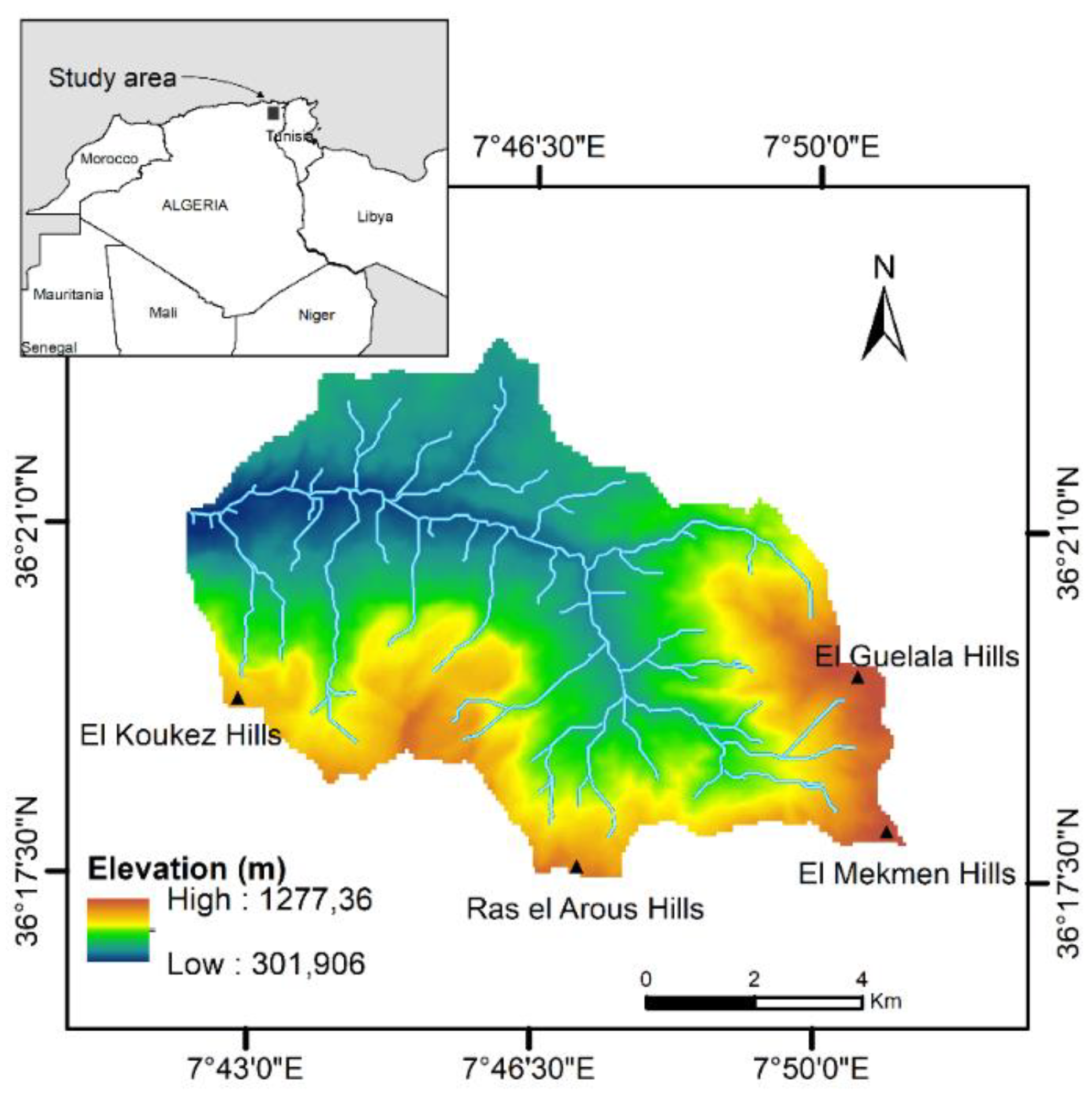
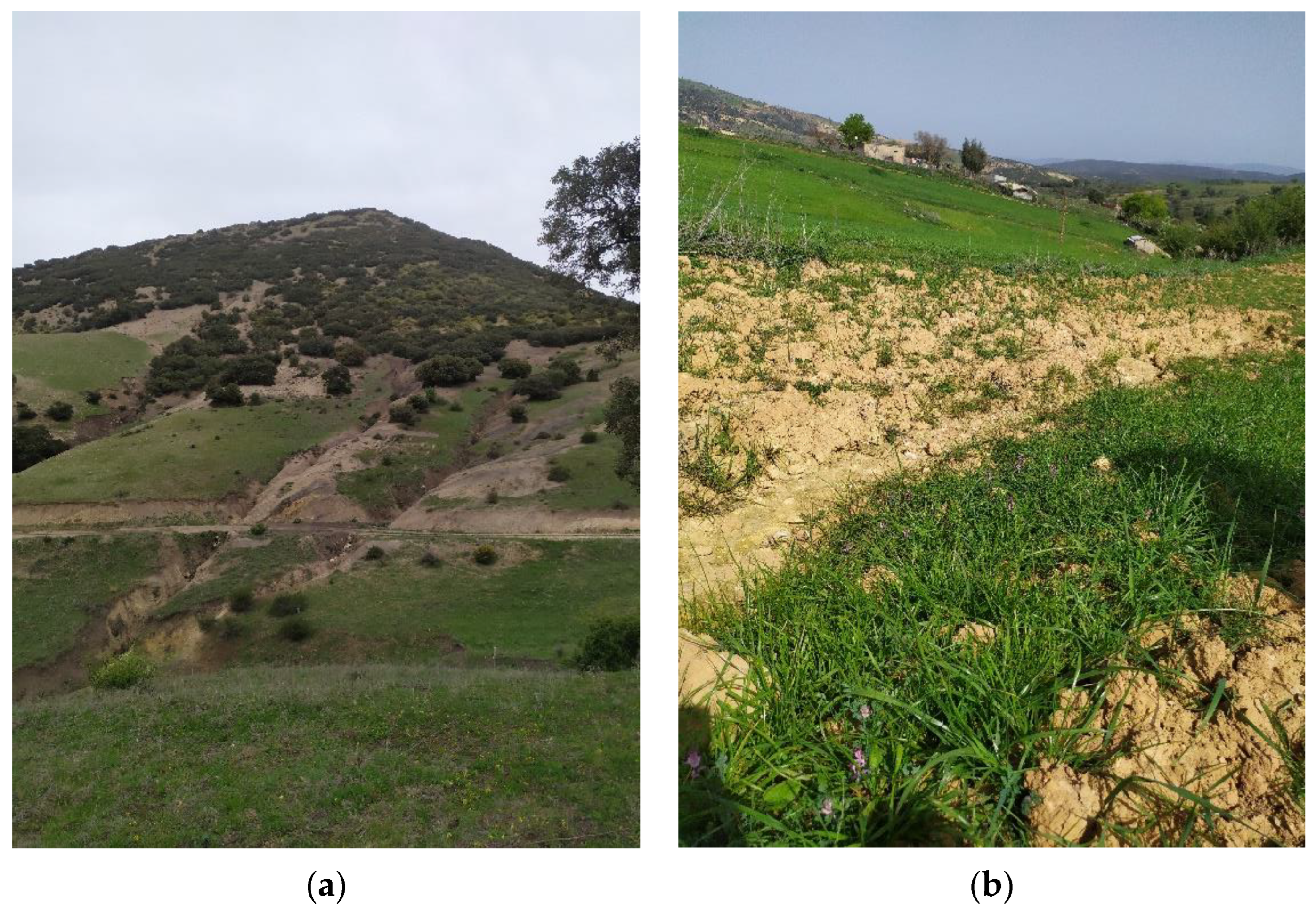
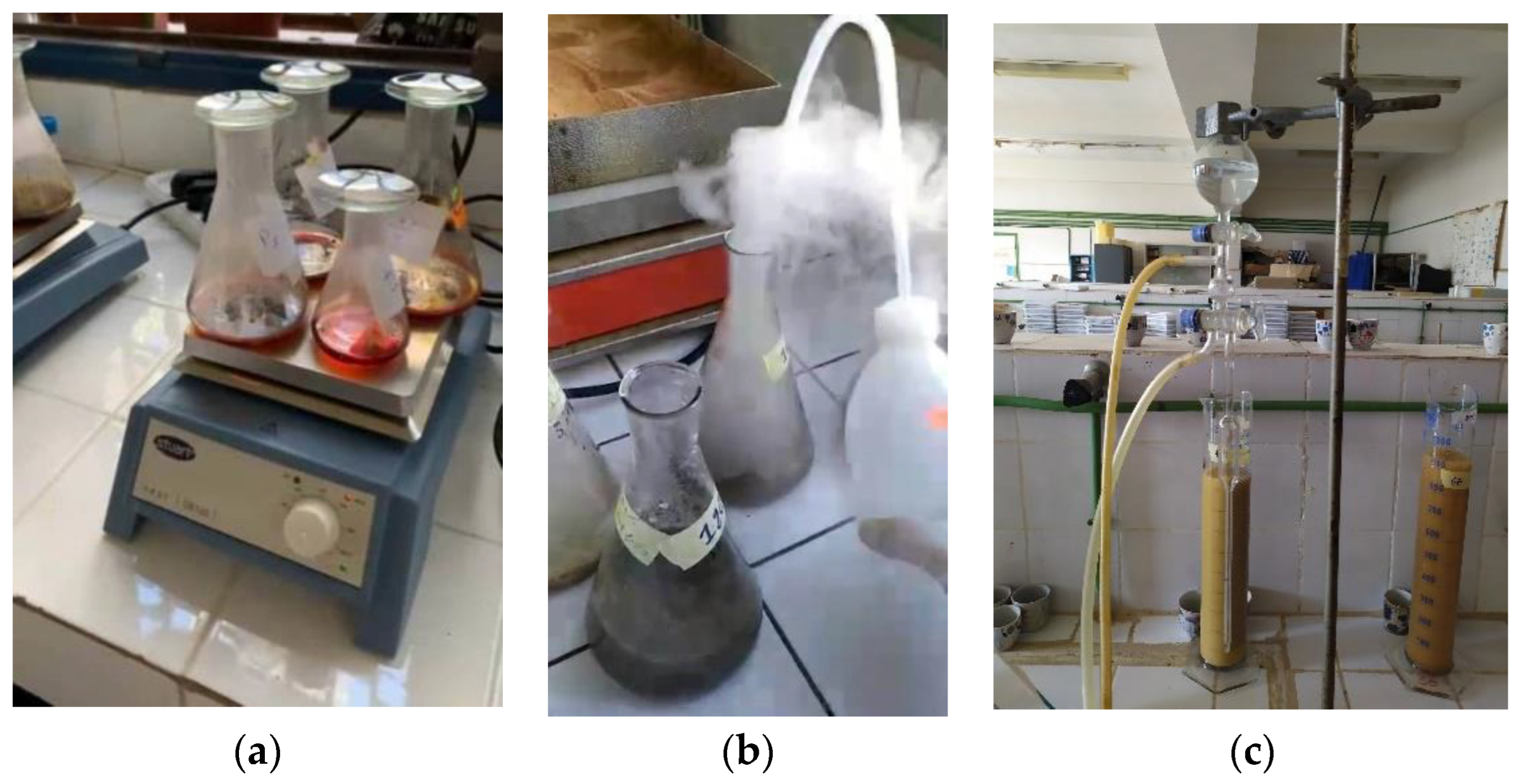
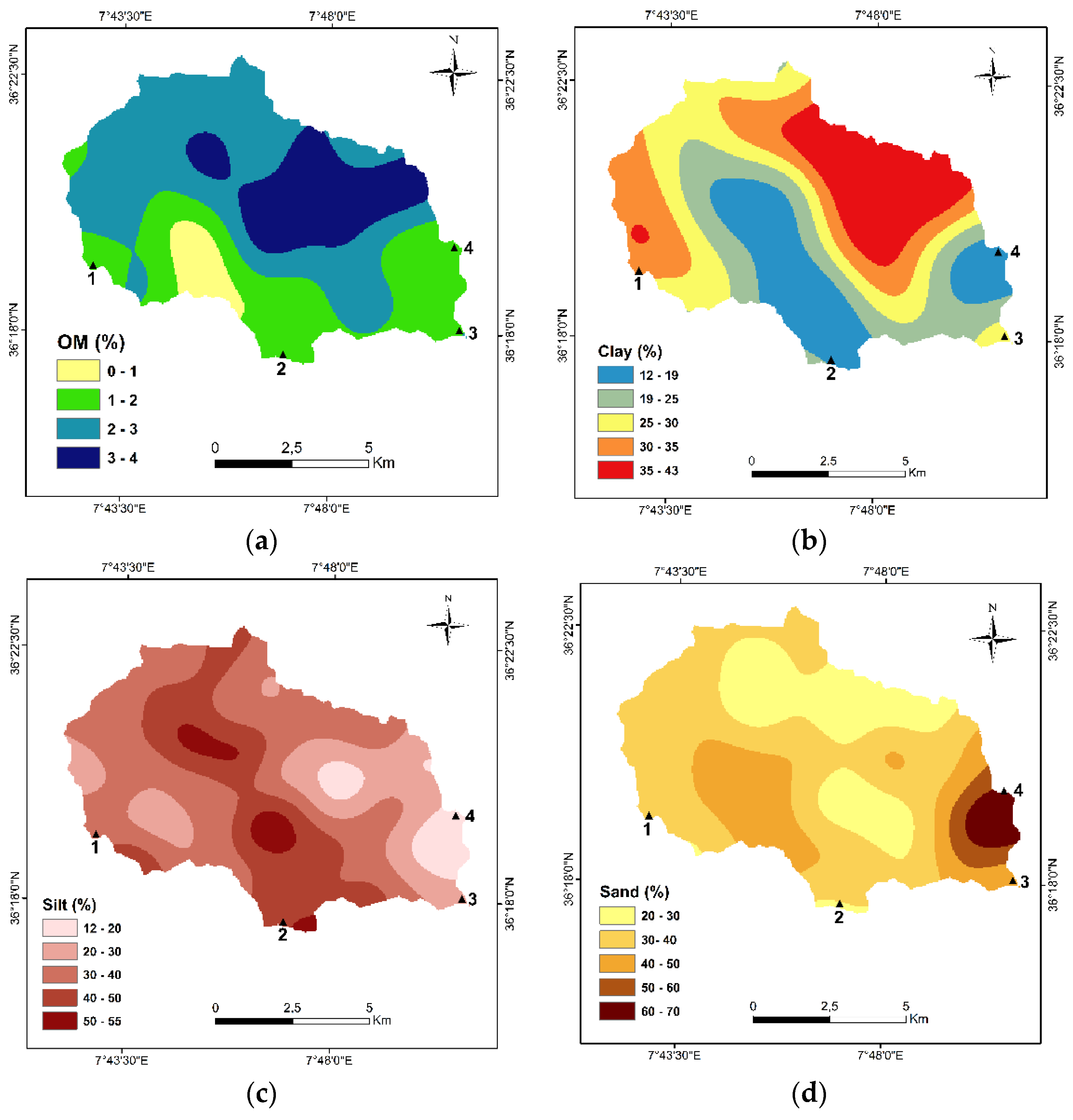
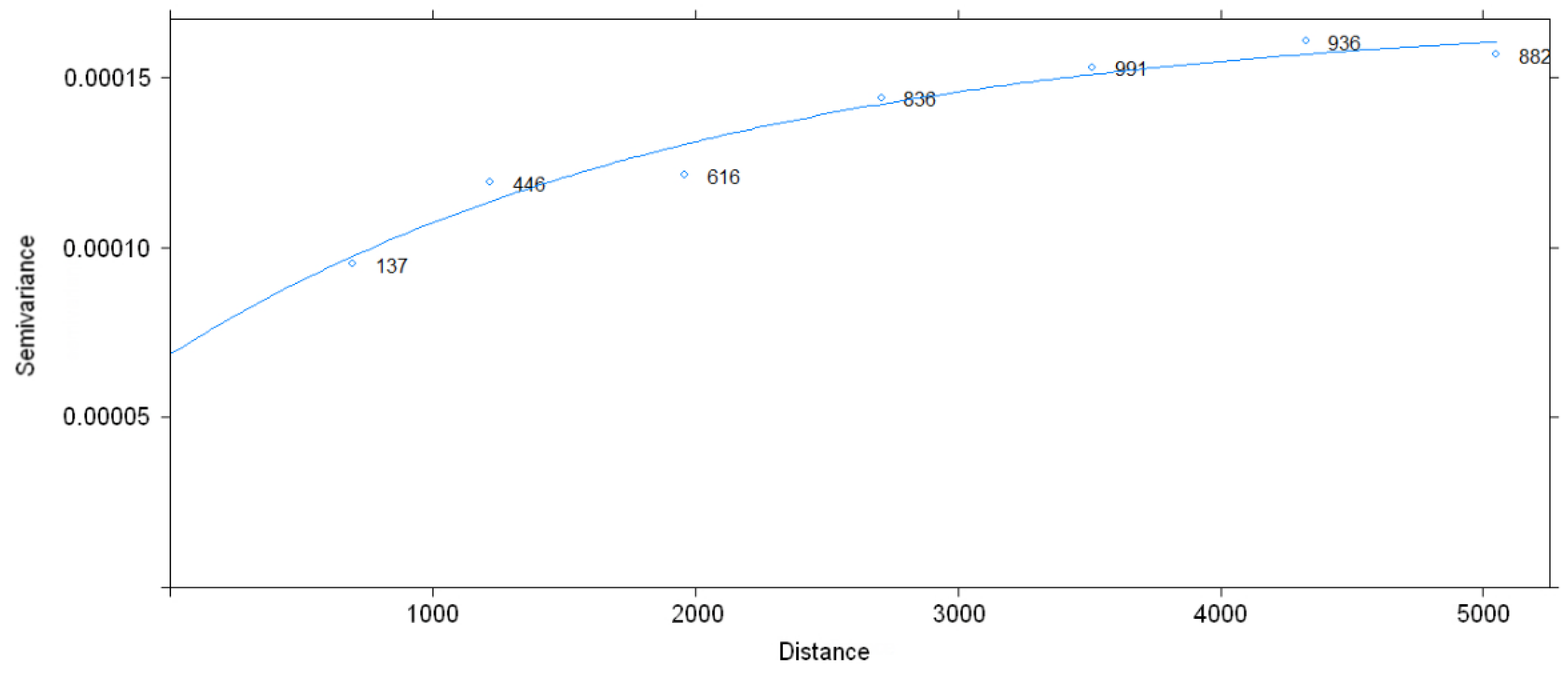
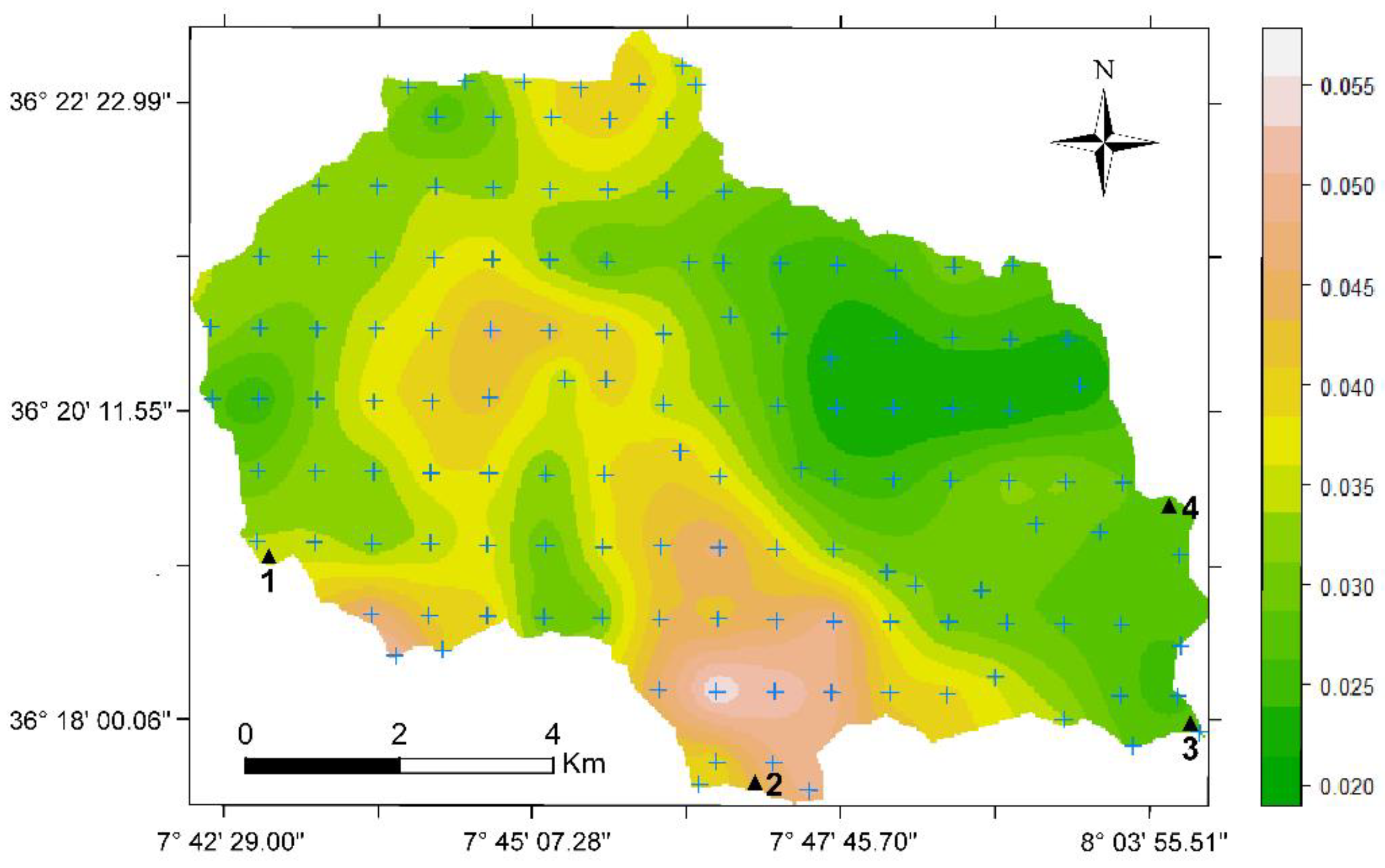
| Parameters | Sand | Clay | Silt | OM | K |
|---|---|---|---|---|---|
| Min | 9.36 | 0.76 | 4.28 | 0.12 | 0.012 |
| Max | 64.95 | 59.04 | 62.80 | 4.80 | 0.066 |
| Mean | 30.21 | 23.96 | 29.46 | 2.31 | 0.034 |
| SD | 10.69 | 13.29 | 11.83 | 1.25 | 0.012 |
| Cv | 35.37 | 55.48 | 40.14 | 54.01 | 35.71 |
| Skewness | 0.63 | 0.30 | 0.52 | 0.08 | 0.77 |
| Kurtosis | 0.70 | −0.94 | 0.31 | −1.02 | 0.71 |
| K Factor | Organic Matter (%) | Soil Structure | Soil Permeability | ||||||
|---|---|---|---|---|---|---|---|---|---|
| N | M | SD | M | SD | M | SD | M | SD | |
| Leptosol | 14 | 0.027 | 0.006 | 1.58 | 0.96 | 1.21 | 0.58 | 3.29 | 1.44 |
| Calcic Cambisol | 100 | 0.035 | 0.012 | 2.21 | 1.22 | 1.88 | 0.88 | 3.88 | 1.15 |
| Chromic Cambisol | 18 | 0.030 | 0.014 | 3.40 | 0.88 | 2.00 | 0.91 | 3.89 | 1.18 |
| (%) | Sand | Clay | Silt | Texture | ||||
|---|---|---|---|---|---|---|---|---|
| N | M | SD | M | SD | M | SD | ||
| Leptosol | 14 | 45.09 | 15.42 | 17.04 | 11.76 | 17.37 | 7.41 | Sandy loam |
| Calcic Cambisol | 100 | 28.81 | 9.40 | 24.53 | 12.53 | 31.53 | 10.95 | Loam and clay loam |
| Chromic Cambisol | 18 | 32.79 | 14.82 | 25.48 | 17.51 | 29.27 | 15.89 | Silt loam |
| Soil | Predominant Land Use | Other Land Use | Mean SSI (%) | Minimum Value (%) | Maximum Value (%) |
|---|---|---|---|---|---|
| All soil data | / | 8 | 0.57 | 51.86 | |
| Calcic Cambisol | Crops | Bare land, shrubs, Grassland | 7 | 0.57 | 19.61 |
| Chromic Cambisol | Grassland and shrubs | Crops, bare land | 13.17 | 4.58 | 51.86 |
| Leptosol | Rangelands and grassland | Sparse shrubs | 8.43 | 2.41 | 17.85 |
| Variables | SSI (%) | Sand (%) | Clay (%) | Silt (%) | Perm. (%) | OM | Struc. | K |
|---|---|---|---|---|---|---|---|---|
| SSI (%) | 1.00 | |||||||
| Sand (%) | 0.28 | 1.00 | ||||||
| Clay (%) | −0.08 | −0.32 | 1.00 | |||||
| Silt (%) | −0.33 | −0.69 | −0.16 | 1.00 | ||||
| Perm. | −0.09 | −0.46 | 0.88 | −0.04 | 1.00 | |||
| OM | 0.67 | −0.22 | 0.35 | 0.05 | 0.36 | 1.00 | ||
| Struc. | 0.14 | −0.35 | −0.01 | 0.27 | 0.07 | 0.22 | 1.00 | |
| K | −0.26 | −0.16 | −0.56 | 0.63 | −0.41 | −0.32 | −0.40 | 1.00 |
| Permeability | Number of Samples | % | Studied Soils |
|---|---|---|---|
| 2 | 11 | 8.33 | Leptosols |
| 3 | 52 | 39.39 | Calcic Cambisols |
| 4 | 41 | 31.06 | Leptosols |
| 5 | 6 | 4.55 | Chromic Cambisols |
| 6 | 22 | 16.67 | Chcromic Cambisols |
| Total | 132 | 100 |
Disclaimer/Publisher’s Note: The statements, opinions and data contained in all publications are solely those of the individual author(s) and contributor(s) and not of MDPI and/or the editor(s). MDPI and/or the editor(s) disclaim responsibility for any injury to people or property resulting from any ideas, methods, instructions or products referred to in the content. |
© 2023 by the authors. Licensee MDPI, Basel, Switzerland. This article is an open access article distributed under the terms and conditions of the Creative Commons Attribution (CC BY) license (https://creativecommons.org/licenses/by/4.0/).
Share and Cite
Othmani, O.; Khanchoul, K.; Boubehziz, S.; Bouguerra, H.; Benslama, A.; Navarro-Pedreño, J. Spatial Variability of Soil Erodibility at the Rhirane Catchment Using Geostatistical Analysis. Soil Syst. 2023, 7, 32. https://doi.org/10.3390/soilsystems7020032
Othmani O, Khanchoul K, Boubehziz S, Bouguerra H, Benslama A, Navarro-Pedreño J. Spatial Variability of Soil Erodibility at the Rhirane Catchment Using Geostatistical Analysis. Soil Systems. 2023; 7(2):32. https://doi.org/10.3390/soilsystems7020032
Chicago/Turabian StyleOthmani, Ouafa, Kamel Khanchoul, Sana Boubehziz, Hamza Bouguerra, Abderraouf Benslama, and Jose Navarro-Pedreño. 2023. "Spatial Variability of Soil Erodibility at the Rhirane Catchment Using Geostatistical Analysis" Soil Systems 7, no. 2: 32. https://doi.org/10.3390/soilsystems7020032
APA StyleOthmani, O., Khanchoul, K., Boubehziz, S., Bouguerra, H., Benslama, A., & Navarro-Pedreño, J. (2023). Spatial Variability of Soil Erodibility at the Rhirane Catchment Using Geostatistical Analysis. Soil Systems, 7(2), 32. https://doi.org/10.3390/soilsystems7020032







